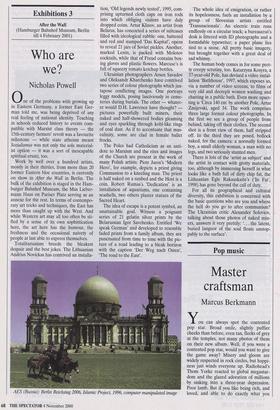Exhibitions 3
After the Wall (Hamburger Bahnhof Museum, Berlin till 4 February 2001)
Who are we?
Nicholas Powell
One of the problems with growing up in Eastern Germany, a former East Ger- man told me, was being deprived of any real feeling of national identity. Teaching in schools reduced history to events com- patible with Marxist class theory — the 15th-century farmers' revolt was a favourite milestone — while state atheism meant Sozialismus was not only the sole material- ist option — it was a sort of inescapable spiritual ersatz, too.
Work by well over a hundred artists, mostly in their thirties, from more than 20 former Eastern bloc countries, is currently on show in After the Wall in Berlin. The bulk of the exhibition is staged in the Ham- burger Bahnhof Museum, the Max Lieber- mann Haus on Pariser Platz serving as an annexe for the rest. In terms of contempo- rary art tricks and techniques, the East has more than caught up with the West. And while Western art may all too often be sti- fled by a sense of its own sophistication here, the art here has the humour, the freshness and the occasional naivety of people at last able to express themselves.
Totalitarianism breeds the bleakest despair and the best jokes. The Lithuanian Andrius Novickas has contrived an installa- tion, 'Old legends newly tested', 1995, com- prising upturned cloth caps on iron rods into which obliging visitors have duly dropped coins. Artur Klinov, an artist from Belarus, has concocted a series of suitcases filled with ideological rubble: one, battered and red and stamped 'Das Kapital', opens to reveal 21 jars of Soviet pickles. Another, marked Lenin, is packed with Molotov cocktails, while that of Freud contains box- ing gloves and plastic flowers. Marcuse's is full of squeezy tomato ketchup bottles.
Ukrainian photographers Arsen Savadov and Oleksandr Kharchenko have contrived two series of colour photographs which jux- tapose conflicting images. One portrays leggy models, posing lasciviously in ceme- teries during burials. The other — whatev- er would D.H. Lawrence have thought? pictures powerfully built miners, their naked and half-showered bodies gleaming and eyes sparkling through kohl-like rings of coal dust. As if to accentuate that mas- culinity, some are clad in female ballet frocks.
The Poles had Catholicism as an anti- dote to Marxism and the rites and images of the Church are present in the work of many Polish artists: Piotr Jaros's 'Modern Hero', for example, depicts a priest giving Communion to a kneeling man. The priest is half naked on a sunbed and the Host is a coin. Robert Rumas's 'Dedication' is an installation of aquariums, one containing seashells, two others plaster statues of the Sacred Heart.
The idea of escape is a potent symbol, an unattainable goal. Witness a poignant series of 21 gelatin silver prints by the Belarussian Igor Savchenko. Entitled 'We speak German' and developed to resemble faded prints from a family album, they are punctuated from time to time with the pic- ture of a road leading to a bleak horizon with the caption Der Weg nach Osten', `The road to the East'. The whole idea of emigration, or rather its hopelessness, fuels an installation by a group of Slovenian artists entitled `Transnacionala'. An electric train runs endlessly on a circular track; a bureaucrat's desk is littered with ID photographs and a formidable typewriter; a paper plane lies tied to a stone. All pretty basic imagery, but brought together with a great deal of sad whimsy.
The human body comes in for some pret- ty creepy scrutiny, too. Katarzyna Kosyra, a 37-year-old Pole, has devised a video instal- lation 'Bathhouse', 1997, which exposes us, via a number of video screens, to films of very old and decrepit women washing and chatting in a public bath. Even more upset- ting is 'Circa 140 cm' by another Pole, Artur Zmijevski, aged 34. The work comprises three large format colour photographs. In the first we see a group of people from behind, taking off their clothes. The second shot is a front view of them, half stripped off. In the third they are posed, bollock naked, for the camera: a normally formed boy, a small elderly woman, a man with no legs, and two seriously stunted men.
There is lots of the 'artist as subject' and the artist in contact with grotty materials, too, although by immersing herself in what looks like a bath full of dirty chip fat, the Lithuanian Egle Rakauskaite's (In Fat', 1998) has gone beyond the call of duty.
For all its geographical and cultural diversity, this exhibition is concerned with the basic questions who are you and where the hell do you go to after communism? The Ukrainian critic Alexander Soloviov, talking about those photos of naked min- ers, answers it very prettily: `... the latent, buried languor of the soul floats unstop- pably to the surface'.


























































































 Previous page
Previous page